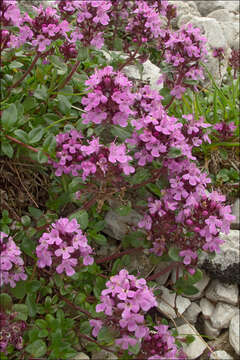Thymus-pulegioides-ssp-carniolicus_3

Description:
Thymus pulegioides ssp. carniolicus (Borbas) Schmidt , syn.: Thymus carniolicus Borbas, Thymus froelichianus OpizCarniolian Thyme, DE: Krainer Thymian, Krainer QuendelSlo.: kranjska polajeva materina duicaDat.: Aug. 1. 2014Lat.: 46.44256 Long.: 13.64312Code: Bot_820/2014_IMG6450Habitat: very stony grassland, almost scree slope, southeast inclined moderately steep mountain slope, open place, full sun, relatively dry, skeletal calcareous ground with outcropped rocks, some siliceous acid rock intermeshed; exposed to direct precipitations, average precipitations ~ 3.000 mm/year, average temperature about 0 - 2 deg C, elevation from 1.995 m, (from 6.550 feet), alpine phytogeographical region. Substratum: soil among stones and scree.Place: Mt. Mangart region, Mangart's flats, below terminal loop of the Mt. Mangart alpine road, south of Mt. Travnik, 2.200 m (7.218 feet), East Julian Alps, Posoje, Slovenia EC.Comments: In spite of the fact that thyme (Thymus) is a popular plant, well known for its medical use, intense and pleasant aroma and use as spice and tea herb, it is a difficult genus for reliable botanical determination to species and lower taxonomical level even for professionals. Its members are highly variable and crosses are frequent. No wonder, a large number of (many taxonomically questionable) taxa have been described in literature. Since different authors threat the genus differently there is a kind of mess in the literature for an amateur. Consider, for example, the fact that Flora Alpina (Ref.: 1) reduced about 70 described taxa growing in Europe into thirteen, Exkursionsflora (Ref.: 2) (for Austria) into ten, Slovenian key (Ref.: 3) (for Slovenia) into nine, and Flora Helvetica (Ref.: 4) into seven only species and subspecies. In practice very often plants found in nature 'don't want' to fit to the books. This has happened also with the plants on my photos.The closest fit I was able to find wasThymus pulegioides ssp. carniolicus. This taxon has a relatively easily recognizable (even though a magnifier is needed) specific trait, which should theoretically suffice for a reliable determination.Namely, the stem of flowering shoots is all the way to the top rectangular in cross-section. This alone is true also with few other types of thyme. However, with Thymus pulegioides ssp. carniolicusthe cross-section is not square, but two opposite sides are distinctly shorter than other two. The shorter sides are always curved inward (concave) and covered with short hairs. In opposite to this, the longer sides of the cross-section are without hairs (glabrous) and flat or slightly curved outward (convex). The funniest detail is that at each node of the flowering stem (where the leaves grow out) these two types of surfaces alternate. Say, below the node left and right sides of the rectangular stem are shorter and hairy and longer front and back sides are glabrous. Above the node the front and back sides are shorter and hairy and left and right sides are longer and without hairs. Above the next higher node left and right sides are again shorter and hairy and so on.This pattern was clearly present with the plants photographed. However there is also an important discrepancy. According to literature Thymus pulegioides ssp. carniolicus should have hairy leaves on both sides. But the leaves of the photographed plants were almost without hairs. Also the distinct hairs along stem edges (they are characteristic of several other Thymus species too) are shorter than expected. They should regularly exceed the stem diameter, but observed hairs were shorter. Since, as already said, hybrids in this genus are frequent, it isn't impossible that I photographed a cross between Thymus pulegioides ssp. carniolicus and some other taxa, most probably quite common Thymus pulegioides ssp. pulegioides or perhapsThymus alpestris.Ref.:(1) D. Aeschimann, K. Lauber, D.M. Moser, J.P. Theurillat, Flora Alpina, Vol. 1., Haupt (2004), p 154.(2) M.A. Fischer, W. Adler, K. Oswald, Exkursionsflora sterreich Liechtenstein,Sdtirol, LO Landesmuseen, Linz, Austria (2005), p 783.(3) A. Martini et all., Mala Flora Slovenije, Tehnina Zaloba Slovenije (2007) (inSlovene), p 611. (4) K. Lauber and G. Wagner, Flora Helvetica, 5. Auflage, Haupt (2012), p 846.
Included On The Following Pages:
- Life (creatures)
- Cellular (cellular organisms)
- Eukaryota (eukaryotes)
- Archaeplastida (plants)
- Chloroplastida (green plants)
- Streptophyta
- Embryophytes
- Tracheophyta (ferns)
- Spermatophytes (seed plants)
- Angiosperms (Dicotyledons)
- Eudicots
- Superasterids
- Asterids
- Lamiales ("An Order: Mints, Vervains, Snapdragons, Etc.")
- Lamiaceae (mint family)
- Thymus (thyme)
- Thymus pulegioides (Large Thyme)
- Thymus pulegioides pannonicus
This image is not featured in any collections.
Source Information
- license
- cc-by-nc-sa
- copyright
- Amadej Trnkoczy
- photographer
- Amadej Trnkoczy
- original
- original media file
- visit source
- partner site
- Flickr Group
- ID


